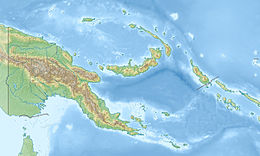2002 Sandaun earthquake
 ShakeMap produced by United States Geological Survey | |
| UTC time | 2002-09-08 18:44:23 |
|---|---|
| ISC event | 3362959 |
| USGS-ANSS | ComCat |
| Local date | 9 September 2002 |
| Local time | 04:44:23 (UTC+10:00) |
| Magnitude | 7.6 Mw |
| Depth | 13 km (8 mi) |
| Epicenter | 3°18′07″S 142°56′42″E / 3.302°S 142.945°E |
| Type | Reverse |
| Areas affected | Papua New Guinea |
| Max. intensity | MMI IX (Violent)[1] |
| Tsunami | 5 m (16 ft) in Victoria Bay[2] |
| Casualties | 6 dead, 70 injured[3] |
On 9 September 2002, a magnitude 7.6 earthquake struck off the coast of Wewak, Sandaun Province, Papua New Guinea. The shallow reverse earthquake triggered a local tsunami measuring 5 meters high. The disaster resulted in at least 6 deaths, 70 injuries and building damage.
Tectonic setting
[edit]The island of New Guinea lies within the complex zone of collision between the Australian plate and the Pacific plate. Within this overall setting, the active tectonics of northern Papua New Guinea is dominate by the effects of continuing collision between the Huon–Finisterre island arc terrane with the edge of the Australian continental margin. The overall shortening is concentrated into two zones of thrust faulting, the Ramu–Markham fault zone, which forms the southwestern boundary of the Huon–Finisterre terrane, and the Highlands Thrust Belt, which lies further southwest and deforms the Australian margin.[4] The hanging wall of the Ramu–Markham thrust system is broken up by a series of strike-slip faults. The orientation of these faults, parallel to the direction of thrusting, suggests that they accommodate distortion of the Huon–Finisterre block. Most of the seismicity in northern Papua New Guinea is associated with the Ramu–Markham fault system, with a smaller number of earthquakes occurring on the strike-slip faults and on the Highlands Thrust Belt.
Earthquake
[edit]The earthquake was the largest in the Aitape region since 1938.[5] The overall magnitude ranges from 7.2 to 7.7.[3] The United States Geological Survey estimates a magnitude of 7.6. It was caused by a rupture on a low-angle thrust fault in the New Guinea Trench. A fault measuring 72 km in length, and 36 km wide ruptured with a maximum slip of 2.1 meters.[6]
Tsunami
[edit]A tsunami warning was issued in the region. In East Sepik, a 5.01 m (16.4 ft) wave hit the area, destroying several homes.[7][2] Ten-centimeter waves hit southern Japan.[2] The tsunami was moderate in height; at 1.5 meters along most of the coastline. On several islands however, the run-up was 5 meters. The tsunami's western reach were at Sissano Lagoon and Aitape, which suffered extreme destruction during the 1998 earthquake and tsunami. The high tsunami run-ups in bays were due to the funnel-effect which increased the heights of the waves.[6]
Damage and casualties
[edit]In Wewak, the closest town to the epicentre, at least 700 homes were damaged or destroyed, along with pipelines and a bridge.[8][3] All schools in the town were temporarily closed.[8] Three were killed when their houses collapsed. Seventy people were injured, and 3,000 people were made homeless. A woman succumbed to her injuries later at hospital.[9][10] Two more people, including a child were killed by the following tsunami.[7] In West Sepik, ten homes and five water tanks were destroyed however no one was injured.[9] Ubidnim village suffered severe liquefaction when water and sand erupted from the ground as high as 5 meters. Small uplifts of 30–40 cm was measured on several islands and the coast of Papua New Guinea. On Tarawai Island, two instances of uplift were observed, separated by an hour.[6]
See also
[edit]- 1998 Papua New Guinea earthquake
- List of earthquakes in 2002
- List of earthquakes in Papua New Guinea
References
[edit]- ^ "PAGER" (PDF). United States Geological Survey. 25 February 2018.
- ^ a b c "Tsunami Event – PAPUA NEW GUINEA". National Geophysical Data Center.
- ^ a b c "M 7.6 – 68 km ESE of Aitape, Papua New Guinea". United States Geological Survey.
- ^ Abers, G.A.; McCaffrey, R. (1994). "Active arc-continent collision: Earthquakes, gravity anomalies, and fault kinematics in the Huon-Finisterre collision zone, Papua New Guinea". Tectonics. 13 (2): 227–245. Bibcode:1994Tecto..13..227A. doi:10.1029/93TC02940.
- ^ "M 7.7 – eastern New Guinea region, Papua New Guinea". United States Geological Survey. 12 May 1938. Retrieved 21 May 2016.
- ^ a b c Ryan Ruddick (2005). Analysis of the 2002 Mw = 7.6 Wewak Earthquake, Papua New Guinea, using Global Positioning System Observations (PDF) (Honours). Australian National University.
- ^ a b "Huge quake hits Papua New Guinea". BBC News. 9 September 2002.
- ^ a b "Wewak schools closed". Papua New Guinea Post-Courier. Archived from the original on 12 September 2002.
- ^ a b "Papua New Guinea – Earthquake OCHA Situation Report No. 2". ReliefWeb. Archived from the original on 6 December 2004.
- ^ "Earthquake leaves 3,000 homeless". The Sydney Morning Herald. 10 September 2002.


